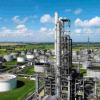Background:
During commissioning of our newly constructed plant we discovered a design flaw in some of our heat exchangers that have cooling water on the low pressure side (DP of the CW network = 10 barg, hydrotest = 15 barg) and syngas on the high pressure side (ca. 140 bar).
The design pressure of the LP side of the exchangers has been upgraded to the 2/3rds rule, the low pressure side exchanger nozzles have also been upgraded - which is pretty typical. However, the connected piping has maintained the original hydrotest pressure of 15 barg.
PSVs have also been situated at quite a far distance from the exchanger (on the return side only) and although they have been sized to relieve the critical vapour flow through a full tube break they haven't considered the initial liquid slug they would need to push out prior to relieving the gas i.e. their response time will be slow. Finally, no transient analysis was conducted which is a code requirement if selecting to deal with tube rupture in this way.
What we have done since discovering this:
First we commissioned a transient analysis on the current as-built and potential re-designs. Our re-designs are very limited due to the project phase - some of the conclusions and constraints are listed for info below:
1. Report shows that the current design will have a pressure spike in the cooling water network that far exceeds the pipework's hydrotest pressure (40ish bar) at the two isolation valves either side of the exchanger. (pipework is 150# carbon steel).
2. We cannot upgrade the entire CW network to a higher design pressure as 95% of it is underground, its already been commissioned and so the cost is astronomical. We can't redo the hydrotest pressure of this pipework either (to the ASME16.5 limits for 150# carbon steel piping - roughly 19 bargx1.5) on the section we can't upgrade as this is also extremely difficult and costly at this stage.
3. We can upgrade the pipework up to the isolation valves (to 300# or above) and we can also add fast acting bursting discs either side of the exchanger.
Points 2 and 3 have meant that we had to consider a design in which we extended the pipework length on return and supply sides of the low pressure side the exchanger before hitting the isolation valves on either side. The idea being that the length of pipe dissipates the pressure spike such that once it gets to the 150# isolation valves it is at or lower than the 15 barg hydrotest pressure.
API 521 4.4.14.2.1 states the following:
"The user may choose a pressure other than the corrected hydrotest pressure, given that a proper detailed mechanical analysis is performed showing that a loss of containment is unlikely.”
My questions are based around this statement. First, what does the statement in API actually mean? - does anyone have experience of interpreting this? Does it mean that we could select a higher pressure than the hydrotest pressure we have already conducted (and that we cannot re-test) without proving it if we add some mechanical analysis checks?
We have already resigned ourselves to the fact we need additional upgraded pipework to dissipate the pressure spike (in addition to the two bursting discs), my concern is that when the new as-built is remodelled we might still be slightly over the 15 barg hydrotest pressure. I was looking at this and considering whether is could be a sort of get-out clause.
Secondly, what would be the mechanical analysis checks to convince ourselves a loss of containment (LOC) cannot happen?
Apologies for the crude accompanying sketch, its the best i could do whilst in transit - it has a mistake on the isolation valves, these are to be retained as 150# so the spec break is on the wrong side. Also ignore the restriction orifices, these are not there or part of the final design.

 FB
FB













